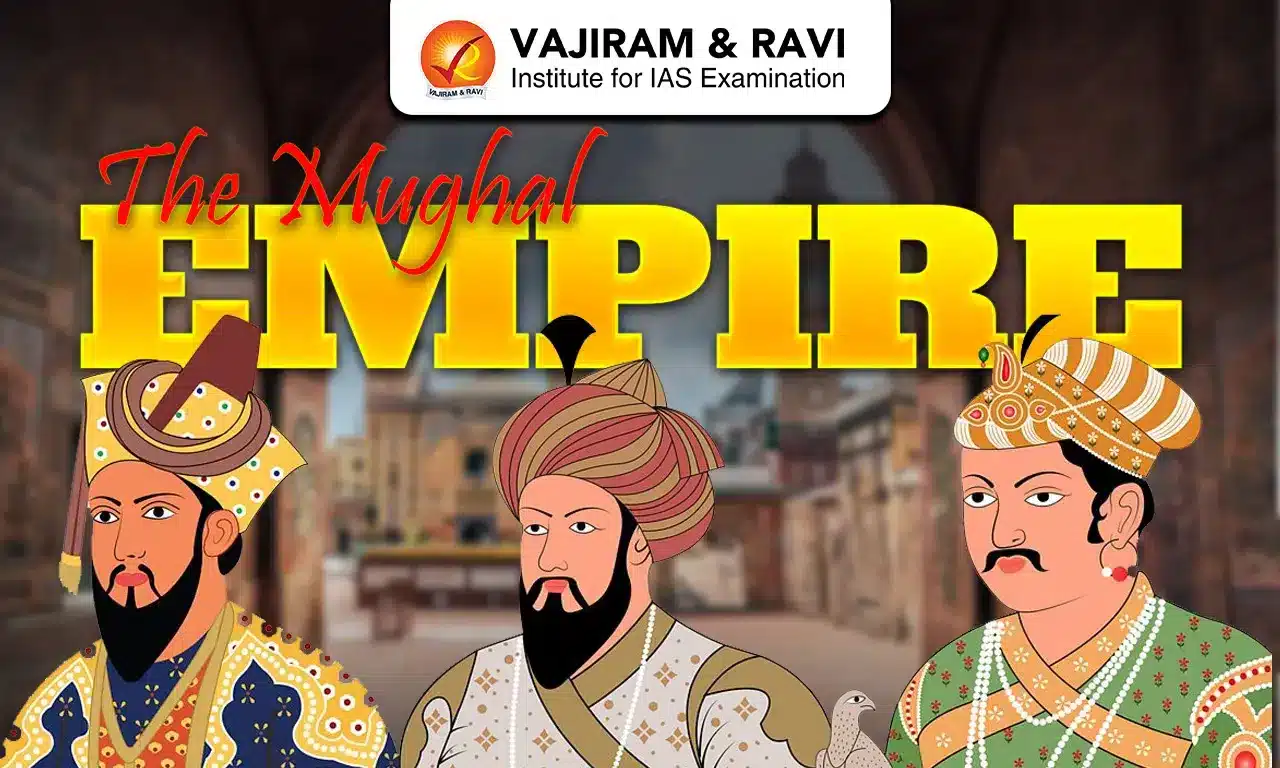Emergence of Mughals
Babur, who dreamed of repeating what Timur had done a century and a quarter earlier, succeeded in founding the Mughal kingdom with Delhi as its capital in 1526 in the wake of the political disintegration of the Delhi Sultanate.
- Developments in Samarkand:
- Babur inherited the throne of Samarkand from his father. He lost his throne with enemies all around him but soon reclaimed it.
- But soon, he realised that, with the powerful Safavid dynasty in Iran and the Uzbeks in Central Asia, he should instead turn to the southeast towards India to build an empire of his own.
- Intention to invade India: Babur had an eye on Punjab as a Timurid, part of which had been Timur’s possession. When he invaded Bhera, Sialkot, and Lahore between 1519 and 1524, he demonstrated his firm intention to conquer Hindustan, where the political scene also favoured his adventure.
- Invasion of Kabul and Ghazni: Babur crossed the Indus to India and established a small kingdom after conquering Kabul and Ghazni.
- Right time: The time for invading India was also ripe as there was discontent among the Afghans and the Rajputs, as Sultan Ibrahim Lodi of the Lodi dynasty was trying to expand his territory.
- Invitation from Daulat Khan Lodi: Babur received an embassy from Daulat Khan Lodi, a principal opponent of Ibrahim Lodi, and Rana Sangha, ruler of Mewar and the chief of the Rajput Confederacy, with a plea to invade India.
- The defeat of Daulat Khan: When Babur marched to India, he first defeated the forces of Daulat Khan Lodi at Lahore as he had gone back on his promise to help Babur.
- Establishment of the dynasty: After defeating Daulat Khan, Babur established the rule of the Mughals, dethroning the Lodis from the seat of Delhi.
Map- Lineage of Mughal dynasty
Map - The Mughal Empire
Administration of the Mughals
The Mughal Empire had a highly centralised, bureaucratic government, most of which was instituted during the rule of the third Mughal emperor Akbar.
- Central government: The Mughal emperor headed the central government; immediately beneath him were four ministries.
- Finance Ministry: The finance/revenue ministry controlled revenues from the empire's territories, calculated tax revenues, and used this information to distribute assignments.
- Military Ministry: The ministry of the military (army/intelligence) was headed by an official titled Mir Bakhshi, who was in charge of military organisation, messenger service, and the mansabdari system.
- Ministry of law/religious patronage: The ministry in charge of law/religious patronage was the responsibility of the sadr-as-sudr, who appointed judges and managed charities and stipends. Another ministry was dedicated to the imperial household and public works.
Administrative divisions
The empire was divided into subha (provinces), each headed by a provincial governor called a Subadar.
- Provincial administration: The structure of the central government was mirrored at the provincial level; each suba had its own bakhshi, sadr-as-sudr, and finance minister that reported directly to the central government rather than the subahdar.
- Local administration:
- Subas were subdivided into administrative units known as sarkars, which were further divided into groups of villages known as Parganas.
- Mughal government in the Pargana consisted of a Muslim judge and local tax collector. Parganas were the basic administrative unit of the Mughal Empire.
- Nature of administrative divisions: Mughal administrative divisions were not static.
- Territories were often rearranged and reconstituted for better administrative control and to extend cultivation.
- For example, a sarkar could turn into a subah, and parganas were often transferred between sarkars.
- Hierarchy of divisions:
- Sometimes, the hierarchy of division was ambiguous, as a territory could fall under multiple overlapping jurisdictions.
- The Mughal state needed more resources or authority to undertake detailed land surveys; hence the geographical limits of these divisions were not formalised, and maps were not created.
- Instead, The Mughals recorded detailed statistics about each division to assess the territory's capacity for revenue based on more superficial land surveys.
Economic conditions during the Mughal Empire
The Mughal economy was primarily agricultural.
- Agriculture: Different classes of the rural population were involved in agriculture. Agriculture was the chief activity in the economy. Landless agricultural labourers without the right to property formed almost a quarter of the population.
- Landholding: Zamindars and village headmen possessed large tracts of land in which they employed labourers and paid them in cash and kind. Well, irrigation was the dominant mode of irrigation.
- Crops: The Ain-i-Akbari lists the various crops cultivated during the Rabi and Kharif seasons.
- Tobacco and maize were introduced in the seventeenth century.
- Chilli and groundnut came later.
- Pineapple was introduced in the sixteenth century.
- Grafted varieties of mango came to be developed by the Portuguese.
- Potato, tomato and guava came later.
- Indigo was another important commercial crop during the Mughal period.
- Sericulture underwent spectacular growth in Bengal to the extent that it became the chief supplier of silk to world trade.
- Forests: The forests provided the raw materials for the artisans. Timber went to carpenters, wood carvers and shipwrights, lacquerware makers; wild silk to reelers and weavers; charcoal to iron miners and metal smiths.
- Land tax: As the farmers were compelled to pay land tax, they had to sell the surplus in the market.
- The land tax was a share of the produce and a major revenue source for the Mughal ruling class.
- The administration determined the productivity of the land and assessed the tax based on the total measurement.
- Land revenue system: Akbar promulgated the Zabt System (introduced by Todal Mal):
- Money revenue rates were now fixed on each unit of area according to the crops cultivated.
- The schedules containing these rates for different localities applicable year after year were called dasturs.
- Urban Economy: The urban economy was based on the craft industry.
- The cotton textile industry employed large numbers of people as cotton carders, spinners, dyers, printers and washers.
- Iron, copper, diamond mining and gun making were other chief occupations.
- Kharkhanas were workshops where expensive craft products were produced.
- The royal karkhanas manufactured articles for the royal family and nobility.
Trade and commerce
The political integration of the country with efficient maintenance of law and order ensured brisk trade and commerce. The surplus was carried to different parts of the country through rivers and the roads on ox and camel-drawn carts.
- Trading centres:
- Bengal was the chief exporting centre of rice, sugar, muslin, silk and food grains.
- The Coromandel coast was reputed for its textile production.
- Kashmiri shawls and carpets were distributed from Lahore, which was an important centre of handicraft production.
- The movement of goods was facilitated by letters of credit called hundi.
- Traders: Banjaras were specialised traders who carried goods in large bulk over long distances.
- The traders came from all religious communities: Hindus, Muslims and Jains.
- The Bohra Muslims of Gujarat, Marwaris of Rajasthan, Chettiars on the Coromandel coast, and Muslims of Malabar were prominent trading Communities.
- Europeans controlled trade with West Asia and European countries and restricted the involvement of Indian traders.
- Europeans imported spices, indigo, Bengal silk, muslin, calico and chintz.
- In return, India obtained large quantities of silver and gold.
- Mughal silver coinage fuelled the demand for silver.
- Sarais: The network of sarais enabled the traders and merchants to travel to various places
Mughal Society
- Population: The population of India is estimated to have been around 15 crores in the 16th century and 20 crores in the 18th century.
- Occupation: As agriculture was the prime occupation of society, the village community was the chief institution of social organisation.
- Villages: Though the village's nature, composition and governance differed from place to place, there were certain similarities in the village administration.
- Village headmen: The Muqaddam formed the Panch (Panchayat), an administrative organ.
- Panch: The Panch was responsible for collecting and maintaining accounts at the village level. The Panch allotted the unoccupied lands of the village to artisans, menials and servants for their service to the village.
- Middle class: The middle class consisted of small Mansabdars, petty shopkeepers, hakims (doctors), musicians, artists, and petty officials of the Mughal administration.
- Salaried class: A salaried class received grants called Madad-i-Mash from the Mughal emperor, local rulers and zamindars. This section often became part of the rural gentry and a link between the village and the town.
- Urban centres: Delhi, Agra, Fatehpur Sikri, Lahore, Ahmadabad, Dacca and Multan were important cities of the empire which could be ranked along with contemporary European cities like London and Paris.
- Social inequalities: The inequality in the standard of life amongst the privileged and the underprivileged classes was evident.
- Among the lower strata of society, the men wore just a langota and the women a sari. Footwear was rare.
- The poor lived in houses made of mud, and their diet consisted of wheat chapatis with pulses and vegetables.
- On the contrary, the Mughal privileged class consisting of zamindars and nobles led an ostentatious life.
- Nobles: The nobles were Mansabdars who received jagirs or land grants as payment according to their ranks.
- The jagirdars were exploitative and oppressive.
- The nobles maintained many servants and large stables of horses and elephants.
- The nobles lived in fine houses containing gardens with fruit trees and running water. They wore the finest of clothing.
- The Zamindars, members of dominant clans and castes with armed retainers, were a dominant class with privilege over the lands of the peasants.
- In his Ain-i-Akbari, Abul Fazal enlists the castes entitled to be zamindars.
- Domicile of nobles: In the Mughal social structure, the nobles came mainly from Central Asia and Iran. Afghans, Indian Muslims (shaikhzadas), Rajputs and Marathas also obtained the status of nobility.
- It is estimated that during the reign of Akbar, over 15% of the nobility consisted of Rajputs. Raja Man Singh, Raja Todar Mal and Raja Birbalwere Rajput nobles of repute during Akbar.
- Social segments in administration: The Rajputs appointed Kayasths and Khatris for various positions in government administration. Jahangir, Shah Jahan and Aurangzeb employed Marathas in their nobility.
- For example, Shaji, the father of Shivaji, served Shah Jahan for some time.
- Migrants from Central Asia: There were continuous migrations from Central Asia as there were better career prospects in India. These migrations led to the enrichment of culture through the assimilation of diversity.
- Combined origin of artists: Though the nobility was divided on ethnic lines, they formed a composite class promoting a syncretic culture by patronising painters, musicians and singers of both Persian and Indian origin.
- Social structure: The caste system was a dominant institution in the society. Castes at lower levels were subject to much repression.
- Despite the popular Bhakti movement raising the banner of revolt against discrimination, the deprived and disadvantaged classes, who were landless peasants, were subject to forced labour.
- Status of women:
- The Hindu women had only limited rights of inheritance.
- Widow remarriage was not permitted among upper-caste women.
- Mughal administration discouraged the practice of sati prevalent among communities of the higher caste.
- Muslim brides were entitled to receive mehr at the time of marriage and had the right to inherit property, though it was not equal to the share of the male members of the family.
Religious developments during the Mughals
During the Mughal Empire, religious developments played a significant role in shaping the socio-cultural landscape of India, witnessing the patronage of diverse religions, architectural achievements, and the emergence of composite culture.
Hinduism:
- Puranic traditions: The Mughal period witnessed a continuing assertion of all the basic elements in Puranic traditions.
- Similarities in Puranic religions: Because of the countless faiths and innumerable customs and practices, having developed in mutual interaction and expressed in large part in the same language (Sanskrit), the different sects of Hinduism yet shared the same idiom and the same or similar deities.
- Vaishnavism: The sixteenth and seventeenth centuries were the centuries of Vaishnavism.
- In his famous devotion verses, Tulsidas (Ramcharitmanas), a great proponent of the Rama cult, portrayed Rama as a god incarnate.
Sikhism
Sikhism originated as a popular monotheistic movement and evolved into one of the recognised religions of the world.
- Guru Granth Sahib: It is the holy book of Sikhs, containing the sayings of Muslim saint Shaikh Farid and Bhakti poets such as Namdev, Kabir, Sain and Ravidas.
- Guru Nanak: He believed in one God who was formless and omnipresent. He condemned image worship and religious rituals.
- He stressed ethical conduct and kindness to all humans and condemned the caste System.
Christianity
- Christianity Along with the European traders came Christian missionaries like Roberto De Nobili and Francis Xavier. The early missionaries were Catholics.
- The first Lutheran missionaries under Danish patronage arrived in 1706 at Tranquebar, and Ziegenbalg translated the New Testament of the Bible into Tamil in 1714, and soon the Old Testament as well.
- This was the earliest translation of the Bible in any Indian language.
Last updated on November, 2025
→ Check out the latest UPSC Syllabus 2026 here.
→ Join Vajiram & Ravi’s Interview Guidance Programme for expert help to crack your final UPSC stage.
→ UPSC Mains Result 2025 is now out.
→ UPSC Notification 2026 is scheduled to be released on January 14, 2026.
→ UPSC Calendar 2026 is released on 15th May, 2025.
→ The UPSC Vacancy 2025 were released 1129, out of which 979 were for UPSC CSE and remaining 150 are for UPSC IFoS.
→ UPSC Prelims 2026 will be conducted on 24th May, 2026 & UPSC Mains 2026 will be conducted on 21st August 2026.
→ The UPSC Selection Process is of 3 stages-Prelims, Mains and Interview.
→ UPSC Result 2024 is released with latest UPSC Marksheet 2024. Check Now!
→ UPSC Prelims Result 2025 is out now for the CSE held on 25 May 2025.
→ UPSC Toppers List 2024 is released now. Shakti Dubey is UPSC AIR 1 2024 Topper.
→ UPSC Prelims Question Paper 2025 and Unofficial Prelims Answer Key 2025 are available now.
→ UPSC Mains Question Paper 2025 is out for Essay, GS 1, 2, 3 & GS 4.
→ UPSC Mains Indian Language Question Paper 2025 is now out.
→ UPSC Mains Optional Question Paper 2025 is now out.
→ Also check Best IAS Coaching in Delhi
The Mughal Empire FAQs
Q1. What was the Jagirdari system?+
Q2. What was the Zamindari system?+
Tags: quest the mughal empire

















